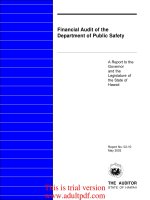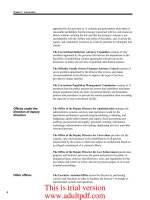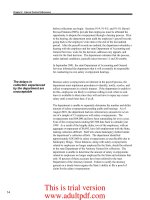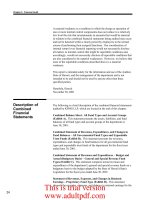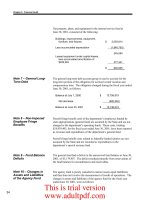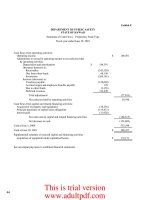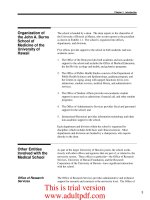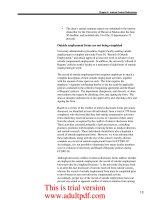FINANCIAL AUDIT First Audit of the Library of Congress Discloses Significant Problems _part2 doc
Bạn đang xem bản rút gọn của tài liệu. Xem và tải ngay bản đầy đủ của tài liệu tại đây (1.1 MB, 10 trang )
Appendix I
Report on Internal Accounting Controls
evaluation of the system to future periods is subject to the risk that pro-
cedures may become inadequate because of changes in conditions or that
the degree of compliance with procedures may deteriorate.
Our preliminary review of the system disclosed conditions that we
believe increase the risk that errors or irregularities that are material to
the Library’s financial statements could occur and not be promptly
detected. We believe that many of these conditions could have been pre-
vented had the Library followed the accounting and financial manage-
ment standards applicable to other federal agencies.
Under 31 U.S.C. 3511 and 3512, federal executive agencies are required
to conform to
GAAP
and the internal control standards prescribed by the
Comptroller General. These requirements are found in
GAO'S
Policy and
Procedures Manual for Guidance of Federal Agencies. These require-
ments are not applicable to the Library since it is a legislative agency.
However, because Library officials have expressed their intent to
comply with many of these requirements, we cite them as criteria
throughout the remainder of this report.
Federal executive agencies are also required to comply with the Federal
Managers’ Financial Integrity Act
(FMFIA)
and the Chief Financial
Officers (CM)) Act of 1990.
FMFIA
requires agencies annually to assess
their internal controls, report on weaknesses, and develop a plan to
strengthen weak internal controls. The CFO Act establishes chief finan-
cial officers and provides for improvements in accounting systems,
internal controls, and financial management to ensure the issuance of
reliable financial information. Among its major requirements are the
(1) annual preparation and audit of financial statements and (2) prepa-
ration and annual update of a 5-year system improvement plan. The 5-
year plan is to include a system integration strategy and relevant mile-
stones. As a legislative branch agency, the Library is not required to
adhere to the requirements of either
FMFIA
or the CFO Act. However, we
believe that these requirements provide a framework for effective
action by the Library to improve its financial management.
Our review disclosed a number of conditions that constituted material
weaknesses in the Library’s system of internal controls. We found that
the Library’s internal control policies, as well as its procedures gov-
erning the accounting and reporting of financial management
information:
Page 9 GAO/AF’MD-91-13 First Audit of the Library of Congress
This is trial version
www.adultpdf.com
Appendix I
Report on Intemal Accounting Controls
. did not ensure that Library assets were properly accounted for, and that
both assets and liabilities were accurately recorded and reported;
.
were not uniformly prescribed, documented, or followed; and
l
did not ensure that
FEDLINK
(1) awarded contracts consistent with its
program purposes, (2) provided and paid for services within applicable
appropriation limits, and (3) properly recorded obligations.
Since we completed our work, the Library has taken a number of actions
to improve its internal controls. These actions represent an important
first step toward addressing the material weaknesses affecting the
Library’s system of internal controls. When completed, these actions
should result in an improved system of internal controls for the Library.
However, given the magnitude and widespread nature of the Library’s
internal control weaknesses, completion of its planned corrective action
will require a substantial, sustained commitment of resources over a
number of years.
Assets and Liabilities
The Library had not established internal control policies and procedures
Not Controlled
to account for and control its assets and liabilities during fiscal year
1988. Specifically, we found that its internal control policies and proce-
dures (1) did not provide adequate accountability for the estimated
89 million items in the Library’s collection or for its other property and
equipment, (2) resulted in the misstatement of the Library’s accounts
receivable, and (3) resulted in the understatement of liabilities and
impeded its payment process from effectively preventing incorrect or
duplicate payments.
Library Collection and
Other Property and
Equipment Not Controlled
The Library estimated that its collection contained nearly 89 million
items worth about $6.8 billion as of September 30, 1988. Among the
Library’s collection are many valuable and irreplaceable items, including
a rough draft of the Declaration of Independence, a Gutenberg Bible, the
first and second drafts of the Gettysburg Address, and musical instru-
ments, including Stradivari violins. We estimated that it also had about
$73 million in other property and equipment at the end of fiscal year
1988.
The Library has established measures to provide physical security over
its assets. Guards are stationed at each exit to scrutinize people leaving
the Library to ensure that they are not removing Library items. More
valuable items in the collection are kept in special secured areas, under
lock and key. The Library’s Divisions use various cataloging systems,
Page 10
GAO/AF’MD91-13 First Audit of the Library of Congress
This is trial version
www.adultpdf.com
Appendix I
Report on Internal Accountings Controls
including automated and manual methods to try to track their various
holdings.
The Library did not have internal control policies and procedures to
accurately determine the size of its collection or the value of its property
and equipment. Title 2 requires that property records be established and
maintained to show all acquisitions, whether by purchase or donation,
as well as disposals. It also requires that when assets, such as those in
the Library’s collection, are reported in the financial statements, they be
recorded in the accounting records at acquisition cost (if purchased),
fair value (if donated or if cost records are not available), or carrying
value (if transferred from another agency).
GAAP
permit libraries to dis-
close their book collections as notes to their financial statements. The
internal control standards also require that periodic physical counts of
all property be performed and compared with recorded amounts. The
Library had not prescribed procedures to control and to provide a com-
plete and accurate record of (1) the cost or fair value and the date of
acquisition for items in its collection and (2) the quantity of items in its
collection. In addition, the Library did not have policies and procedures
requiring a periodic physical inventory of its collection. As a result, it
did not know either the quantity or value of the assets in its collection
and was unable to provide assurance that it could effectively manage
the collection or safeguard it from theft, vandalism, and accidental
destruction.
We found that the quantities reported for the Library’s collection were
based on unsubstantiated records accumulated over many years. The
values were based on the judgment of division chiefs responsible for the
collection. The division chiefs told us that their records were not used to
support the estimate of 89 million items in the various categories of the
collection as of September 30, 1988, and that they did not believe that
the reported quantities were reliable. For example, we found that the
Library lacked internal control policies and procedures to ensure that
recent acquisitions that were waiting to be cataloged were properly
accounted for and controlled. One division chief told us that an esti-
mated two-thirds (or about 9 million) of the items he is responsible for
had not been inventoried and recorded in any Library accounting or
property records. An official from another division told us that about
600,000 items acquired within the past 5 years were stored in boxes in a
warehouse, waiting to be inventoried and recorded.
Division chiefs, who had custodial responsibility for different categories
in the collection, attempted to create some records of the property in
Page 11 GAO/APMD-91-13 First Audit of the Library of Congress
This is trial version
www.adultpdf.com
Appendix I
Report on Internal Accounting Controla
their custody. However, lacking centralized internal control policies and
procedures, the policies and procedures vary and do not meet Title 2
requirements. For example, we determined that some division records
contain titles and bibliographic information while other division records
are in the form of “shelf lists,” which identify only the locations of par-
ticular items. These types of records are not satisfactory property
records for maintaining accountability and achieving effective financial
management because they do not indicate such critical data as quanti-
ties on hand, cost or fair value, and date acquired. Since the Library’s
records did not permit us to determine the quantities on hand, and phys-
ical counts had not been conducted, we were unable to determine how
many items may have been omitted from the property records.
In addition to the Library’s lack of a cumulative general ledger balance
for property and equipment discussed later in this appendix, we found
that (1) there were no records for furniture and furnishings, which is
one category of property and equipment, and (2) the Library did not
conduct a physical inventory of its furniture and furnishings. While we
developed information indicating the value of the Library’s property
and equipment at the end of fiscal year 1988 to be an estimated
$73 million, we could not substantiate the accuracy or reliability of this
estimate.
Included in our overall estimate of the Library’s property and equip-
ment at $73 million, net of accumulated depreciation, is an estimated
$14.5 million for furniture and furnishings, net of accumulated depreci-
ation. We derived the $14.5 million estimate by compiling outlays for
furniture and furnishings over the last 15 years and then deducting our
estimate of accumulated depreciation. This compilation included all
expenditures for furniture and furnishings during this 15-year period,
regardless of whether they met the criteria for capitalization. Such
information does not allow the separation of capitalizable items from
total expenditures or the determination of useful lives as required by
GAAP.
Specifically,
GAAP
require that all property with an initial acquisi-
tion cost of $5,000 or more, and an estimated useful life of 2 years or
more, be capitalized, recorded in property records, and reported in
financial statements.
In its 1991 budget, the Library requested and received resources to work
on its plan to reduce its unprocessed backlog of collection items and
bring it under bibliographic control. For fiscal year 1992, the Library
requested additional resources to ascertain the existence and condition
of each item in its collection and to provide for the use of bar code labels
Page 12 GAO/AFMD-91-13 First Audit of the Library of Congress
This is trial version
www.adultpdf.com
Appendix I
Report on Internal Accounting Controla
to control the movement of items in the collection. Its fiscal year 1992
resource request included funds for conducting a physical count of fur-
niture and furnishings and for establishing and maintaining inventory
records for furniture and furnishings.
Accounts Receivable
Not Determinable
We were unable to determine whether the Library’s $35 million in
reported accounts receivable as of the end of fiscal year 1988 was cor-
rect. However, this amount improperly included amounts for which ser-
vices had not yet been performed in conjunction with its reimbursable
programs and excluded amounts due from nonfederal or quasi-
governmental customers, which should have been reported as receiv-
ables. Also, it had not recorded a liability for advances received.
GAAP
require that amounts received in advance of the provision of ser-
vices should be recognized as a liability until services are rendered.
When the services are rendered,
GAAP
also require that the applicable
portion of the liability be recorded as revenue, with corresponding
adjustments to the liability account. Also, a receivable should be estab-
lished for the amount of any reimbursable services provided for which
reimbursements have not been received.
We found that, for the Library’s largest reimbursable programs
(including
FEDLINK),
its internal control policies and procedures improp-
erly permitted it to recognize not-yet-earned revenue and related
accounts receivable. A Library official told us that he recorded an
account receivable when he sent a customer agency a request for an
advance payment in the amount of the agency’s anticipated usage of
reimbursable services. The Library did not have controls to enable it to
distinguish, in its accounting records, between (1) the amount of the
reported $35 million in accounts receivable it had earned by providing
services and (2) the amount which should not have been recognized as
accounts receivable because services had not yet been performed.
Because the Library records did not indicate whether the related ser-
vices had been performed when receivables were recorded, we were
unable to determine how much of the reported $35 million in accounts
receivable should have been reduced at the end of fiscal year 1988 to
reflect the amount of reimbursable services the Library had yet to
perform.
The Library operated on a cash basis, rather than an accrual basis as
prescribed by
GAAP,
when accounting for
FEDLINK
transactions involving
services to customers it considered to be nonfederal or quasi-
Page 13
GAO/AFMD-91-13 First Audit of the Library of Congress
This is trial version
www.adultpdf.com
Appendix I
Report on Internal Accounting Controls
governmental. We reviewed a file of 10 unprocessed agreements for
about $76,000 in services as of fiscal year-end. These agreements had
been signed but had not been entered in the accounting records. For
eight of these agreements, worth about $74,000, we found that
FEDLINK
services had been provided to the customers in accordance with the
signed agreements, and the Library had made payments to vendors.
However, the Library did not establish accounts receivable when ser-
vices had been provided to these nonfederal or quasi-governmental cus-
tomers and recognized revenue only when cash was received.
At the end of fiscal year 1988, the Library was unable to determine
what portion of the advances it had received was for services that had
not yet been performed. The $46.5 million liability for advances
received and reported in the Library’s fiscal year 1988 financial state-
ments is an unsubstantiated estimate based on the year-end balances
recorded in the general ledgers as undelivered orders for its reimburse-
ment programs. (See note 14, appendix III.)
Rather than revising its accounting system to report accounts receivable
based on services rendered instead of billings sent, after our review, the
Library reported that it had reduced its accounts receivable by actions
such as eliminating service to delinquent customers. Its $35 million in
accounts receivable as of September 30, 1988, was reduced to $8 million
as of March 21, 1991, according to Library officials. Library officials
also said that they no longer treat nonfederal or quasi-governmental
customers differently from other customers, and do not deal with any
who are not authorized to use federal supply sources.
Payment Process Not
Controlled
The Library did not control its payment process. Specifically, we found
that the Library did not record its liabilities as they were incurred and
was unable to effectively prevent duplicate or incorrect payments. As a
result, the Library did not recognize an estimated $23.6 million in liabili-
ties at the end of fiscal year 1988, and, although we did not conclusively
identify any duplicate or incorrect payments, weak controls over pay-
ments increase the Library’s vulnerability in this area.
Title 2 requires that liabilities be recorded when goods and services are
received. To determine whether the Library’s payment process included
the prompt recording of liabilities, we reviewed the payment process
and found that the Library was recording liabilities when the invoices
were in the process of being paid, without regard to the receipt of the
related goods and services. As a result, the Library could not readily
Page 14
GAO/AFMD-91-13 Pirst Audit of the Library of Congress
This is trial version
www.adultpdf.com
Appendix I
Report on Internal Accounting Controls
determine how much it owed vendors for the goods and services it had
received.
To determine the amount of Library liabilities that had not been
recorded in the accounting records at fiscal year-end, we reviewed the
Library’s payments to vendors during the first 3 months after the close
of the fiscal year. From a sample of 579 invoices paid throughout that 3-
month period, we identified the vendor charges applicable to fiscal year
1988 and applied the percentages found to the total invoices paid each
month. As a result, we estimated that the Library had not recorded lia-
bilities of about $23.6 million as of fiscal year-end. At our suggestion,
the Library made adjustments to recognize these additional liabilities in
its September 30, 1988, statement of financial position.
We also noted several weaknesses in the Library’s controls to prevent
incorrect payments to vendors. Title 7 requires that (1) vendor invoices
be voided after payment to prevent reuse in the payment process,
(2) payment be made only on original invoices, rather than copies,
unless special authorization is obtained, and (3) any changes on pay-
ment vouchers indicate proper authorization. Although we did not iden-
tify any duplicate or incorrect payments, the weaknesses we found in
fiscal year 1988 transactions that increase the Library’s vulnerability in
this area include the following:
. Library staff did not void vendor invoices after payment to prevent
reuse in the payment process. Instead, payment data were entered on
voucher worksheets or other cover sheets which were not permanently
attached to the invoices; there was no payment stamp, label, or written
notation on the invoices. If some of these invoices became detached from
the cover sheets, they could accidentally be reentered into the payment
process and paid again without detection.
l
Payments were made, without approval, on copies or duplicates of
invoices. We were told that sometimes the program offices submit dupli-
cate invoices or copies rather than the original. In other cases, the
invoice is misplaced and the vendor is asked to submit a duplicate. In
one instance, the Library paid a vendor $9,405 based on a duplicate
copy of an invoice. In another instance, the Library paid $137 based on
a triplicate copy of an invoice. In both instances, we could find no expla-
nation of why payments were made on other than the original invoices.
Without adequate document control and supervisory approval, unautho-
rized transactions could be entered into the payment process.
. Amounts were changed on payment vouchers after they had been
approved for payment, with no indication as to who made the changes
Page 16
GAO/APMDQl-13 First Audit of the Library of Cougress
This is trial version
www.adultpdf.com
Appendix I
Report on Internal Accounting Controla
or why. On one voucher we examined, a payment listed for $60,980 was
changed to $62,173, with no explanation or identifying signature. On
another voucher, a payment of $1,459 was added without explanation
or identification.
In addition to weaknesses in the Library’s controls allowing duplicate
and incorrect payments, weak controls also impede identifying and cor-
recting such payments. Specifically, the Library did not maintain pay-
ment records (for example, paid invoice files or listings of invoices paid)
in a manner that allowed it to readily identify specific invoices it had
paid. The automated files maintained data by vendor and date paid but
did not identify individual invoices paid. Consequently, in order to iden-
tify any duplicate or incorrect payments, the Library staff would have
to manually search previously processed payment packages and review
the individual invoices paid to a vendor in question.
Library officials informed us after our review that they have revised
the Library’s procedures for estimating accounts payable for fiscal year-
ends 1989 and 1990 so that they would more closely approximate actual
amounts owed. They also said they began to improve controls over pay-
ment processing by voiding vendor invoices after processing, and by no
longer paying on copies of invoices, or letting employees change pay-
ment vouchers without a supervisor’s approval. These changes have not
yet been incorporated into written procedures.
Financial Management
The Library had not uniformly prescribed, documented, or followed the
Policies and
policies and procedures required to effectively control the accounting
and reporting of its financial management information. We found that
Procedures Not
this resulted in a financial management system that was not complete or
Uniformly Prescribed,
integrated. We also found that a fundamental accounting procedure, the
Documented, or
Followed
routine reconciliation of accounts, was not being performed, which
allows erroneous reporting to persist.
Because the Library lacked these fundamental policies and procedures,
it had little or no assurance that personnel involved in processing finan-
cial transactions among the Library’s various components were acting in
conformance with management’s policies or with the requirements of
financial management laws and regulations, In the absence of such guid-
ance, we found that staff tended to develop their own procedures to
meet their needs. Consequently, there is no assurance that the resulting
financial data will be accurate, compatible, consistent, and in accor-
dance with Library policy and
GAAP.
As a result, the Library could not
Page 16
GAO/APMD-91-13 First Audit of the Library of Cmgress
This is trial version
www.adultpdf.com
Appendix I
Report on Internal Accouxdng Controla
ensure the accuracy and reliability of the financial information included
in its internal management reports or in its external reports.
Weaknesses in the Library’s internal control policies and procedures
affecting its overall financial management system structure-specifi-
cally integration and reconciliation-are covered in this section. Weak
Library internal control policy and procedures also affect its ability to
account for and control budgetary resources and other assets and liabili-
ties and are discussed in other sections of this report.
Financial Management
System Not Complete or
Integrated
The Library did not have centralized policies and procedures needed to
control and integrate its financial management system, including a gen-
era1 ledger supported by subsidiary Library accounting systems. As a
result, the Library had no assurance that its financial reports were com-
plete, accurate, and reliable.
Accounting system standards in Title 2 require that the annual financial
statements be the culmination of the entity’s accounting and budgeting
system that is an integral part of its total financial management system.
An agency’s accounting system should also provide for the accumulation
of cost data to account for and manage available resources.
An accounting system which complies with these standards would have
a number of interrelated subsidiary systems. These include a general
ledger and subsidiary systems that account for and control specific
assets and liabilities as well as authorize the use of, and account for and
control, appropriated funds and other resources. Taken as a whole, the
accounting system authorizes, records, classifies, and reports financial
data related to revenues, expenses, costs, assets, liabilities, and govern-
ment equity. Accounting system standards in Title 2 also require that
accounting systems include safeguards to ensure data integrity.
The general ledger should maintain summary information on the
agency’s assets, liabilities, equity, revenues, expenses, costs, losses, and
gains and produce summary financial reports which provide the neces-
sary information for preparing financial statements. The general ledger
should be established and operated so that it will provide control over,
and
draw information from, the subsidiary systems that initially
authorize, record, process, and report individual financial transactions.
Consequently, the information presented in an agency’s financial state-
ments should be traceable to its general ledger and subsidiary systems.
Page 17
GAO/AFMD91-13 First Audit of the Library of Congress
,, :.
This is trial version
www.adultpdf.com
Appendix I
Report on Internal Accounting Controls
The Library uses the automated Financial Accounting and Reporting
System
(FARS)
for the general ledger portion of its accounting system.
During our review of the Library’s accounting operations, we found that
FARS
was not integrated with the numerous systems that generate
accounting data, and consequently did not contain all the data necessary
to produce the required year-end financial reports.
FARS
did not have
information on accounts payable, property and equipment owned by the
Library, the Library’s collection of books and other materials, or on the
cost of reimbursable services provided to other federal agencies and
other entities. For example, because the Library had not established cen-
tralized internal control policies and procedures to guide the establish-
ment and operation of its general ledger, it had-during its year-end
closing procedures
-improperly deleted from its general ledger the cost
of property and equipment purchased during fiscal year 1988. As a
result,
FARS
had a zero cumulative balance for the Library’s property
and equipment at the end of fiscal year 1988. Financial information
needed to support these major accounts had to be reconstructed from
sources outside the Library’s general ledger (for example, program man-
agers and property systems) to support the preparation of year-end
financial reports.
In addition, the Library had no internal control policies and procedures
in place to ensure the accuracy of the data obtained from these other
sources. For example, our examination of the value of the Library’s
property and equipment obtained from other sources showed it to be
unreliable. In an attempt to determine the reliability of the value of
property and equipment for financial statement presentation, we inter-
viewed managers and examined available procurement and budget
office records. Based on this work, we estimated that the Library owned
$73 million worth of property and equipment, net of accumulated depre-
ciation at the end of fiscal year 1988. Our estimate is about $43 million
more than the Library disclosed in its fiscal year 1988 report to the
Department of the Treasury.
According to Library officials, the various units operated their own
accounting or financial management systems with few or no policies and
procedures regarding standard controls that should be used. Several
Library officials told us that each unit acted in its own interest and inde-
pendently determined the extent of controls needed in its own systems
and operations. If Library units are permitted to operate systems with
differing control requirements, the Library will be unable to ensure the
integrity of the data used as a basis for its financial reporting. As a
Page 19
GAO/APMD-91-13 First Audit of the Library of Congress
This is trial version
www.adultpdf.com
